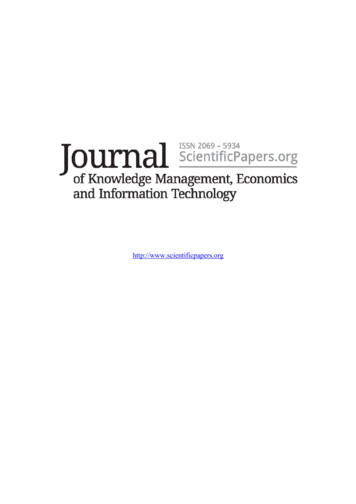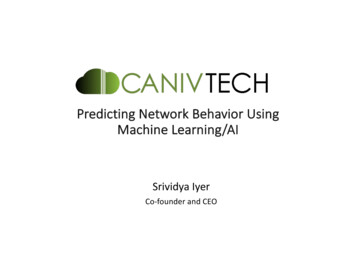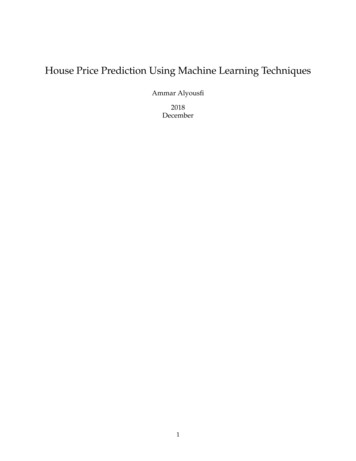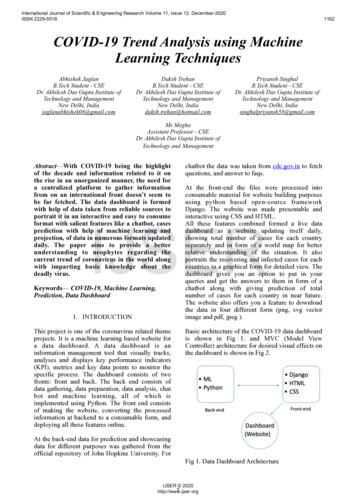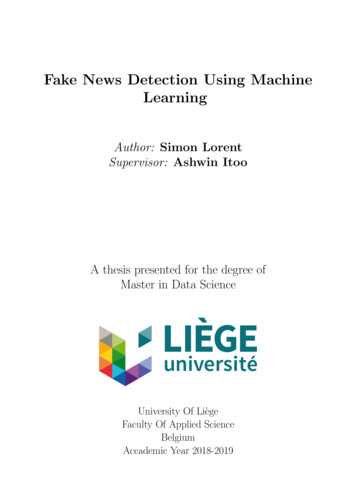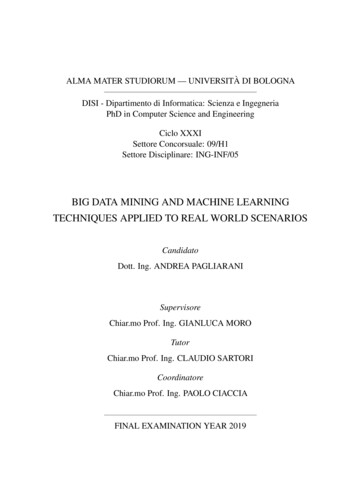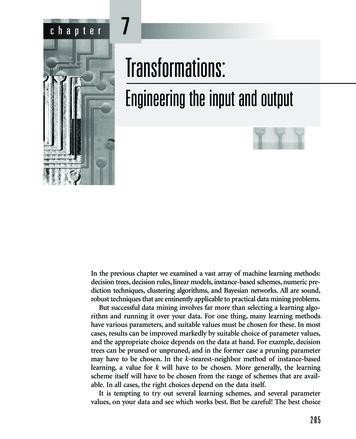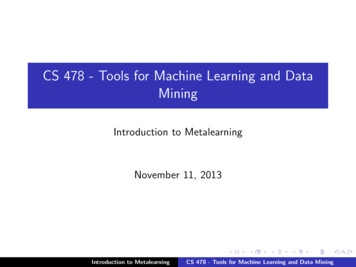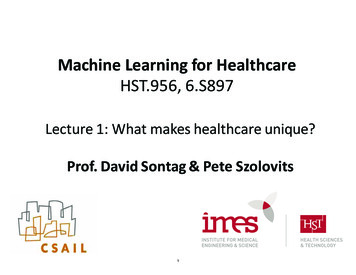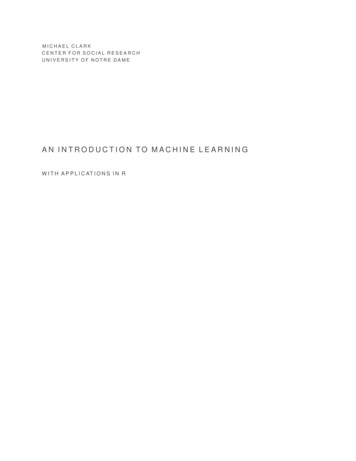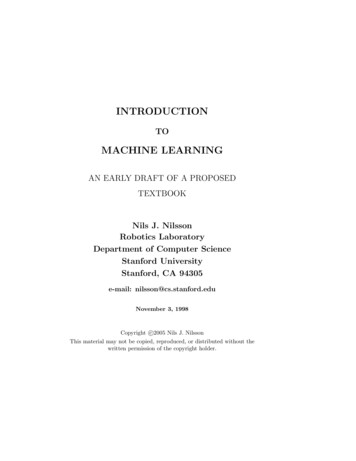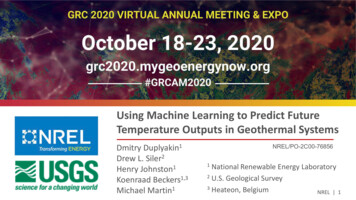
Transcription
Using Machine Learning to Predict FutureTemperature Outputs in Geothermal SystemsTitle SlideDmitry Duplyakin1Drew L. Siler2Henry Johnston1Koenraad Beckers1,3Michael Martin1NREL/PO-2C00-76856National Renewable Energy Laboratory2 U.S. Geological Survey3 Heateon, BelgiumNREL 11
Optimization of a power plant’s outputrequires the ability to predictoutput temperatures and pressuresof production wells based onthe inputs of injection wells, productionmass flow rates, and the history of the fieldApproachProblemMachine Learning (ML) techniques can capturenonlinear relationships betweenindependent/dependent variablesin geothermal ng withadditional channels1-injector, 1-producer analyticalmodel (Song, et al., 2018)Multi-wellmodeling forBrady reservoirNREL 2
Simulations & Data 3D numerical thermo-hydraulic (TH) dualporosity reservoir model developed forBrady Hot Springs in CMG STARS Model validated using historical data Future production temperature andpressure profiles simulated for variousinjection and production flow scenariosTemperature ( C)Initial Reservoir TemperatureExample Temperatures ProfilesML MLP (Multilayer Perceptron)LSTM (Long Short-Term Memory) networksCNN (Convolutional Neural Network)Analytical Model(Song, et al., 2018)2 channels added toproducer’s temperature sequences:injection temperature and mass flowBradyProducer’sInjectors’ currenttemperaturetemperature, pressure, mass flowin the past and now(12 channels for 4 injectors)Future value of producer’s temperatureNRELNREL 3 3
Producer temperatureLearning Brady Reservoir’s data37 simulated scenarios (baseline 36)--------Vary# of neuronsand# of epochsTraining: 24(65%)Train multiple modelsValidation: 3(10%)See which modelgeneralizes bestTest: 10(25%)Evaluate selected model’sprediction accuracy/erroron unseen dataEvaluation Metric:MAPE – Mean AbsolutePercentage ErrorNRELNREL 4 4
Evaluation of Prediction QualityMAPE for individual predicted scenarios(best trained MLP model is shown)Producer temperatureExamples of scenarios predicted from start to finish (2020-2040)Summary of Learning Experiments Future Work:Average MAPE: 1.8 - 6.5%Maximum MAPE: 3 - 16%Errors get smaller if we predict 20 years Train multi-headed networksto predict several quantities Model exergy & energy Run & learn from simulationswith additional constraintsNRELNREL 5 5
References Song, Xianzhi, Yu Shi, Gensheng Li, Ruiyue Yang, Gaosheng Wang, Rui Zheng, Jiacheng Li, and Zehao Lyu. "Numerical simulationof heat extraction performance in enhanced geothermal system with multilateral wells." Applied energy 218 (2018): 325-337.Nwachukwu, Chiazor. "Machine learning solutions for reservoir characterization, management, and optimization." PhD diss.,2018.Ruliandi, Dimas. "Geothermal power plant system performance prediction using artificial neural networks." In 2015 IEEEConference on Technologies for Sustainability (SusTech), pp. 216-223. IEEE, 2015.Prieto, M. M., E. Montanes, and O. Menendez. "Power plant condenser performance forecasting using a non-fully connectedartificial neural network." Energy 26, no. 1 (2001): 65-79.Brownlee, Jason. Deep learning for time series forecasting: Predict the future with MLPs, CNNs and LSTMs in Python. MachineLearning Mastery, 2018.This work was authored in part by the National Renewable Energy Laboratory, operated by Alliance for Sustainable Energy, LLC, forthe U.S. Department of Energy (DOE) under Contract No. DE-AC36-08GO28308. Funding provided by U.S. Department of EnergyOffice of Energy Efficiency and Renewable Energy Geothermal Technologies Office. The views expressed in the article do notnecessarily represent the views of the DOE or the U.S. Government. The U.S. Government retains and the publisher, by acceptingthe article for publication, acknowledges that the U.S. Government retains a nonexclusive, paid-up, irrevocable, worldwide licenseto publish or reproduce the published form of this work, or allow others to do so, for U.S. Government purposes.Acknowledgements We would like to thank John Akerley and John Murphy (Ormat Technologies Inc.)for their collaboration and important contributions to this study.NRELNREL 6 6
Machine Learning Mastery, 2018. NREL 6. This work was authored in part by the National Renewable Energy Laboratory, operated by Alliance for Sustainable Energy, LLC, for the U.S. Department of Energy (DOE) under Contract No. DE -AC36
